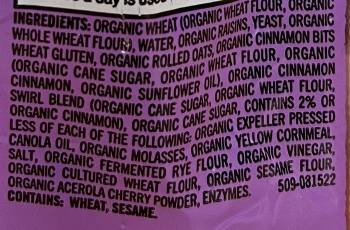Sesame allergy: Food manufacturing shortcut creates new risks

Brent Hofacker - stock.adobe.com.
Allergen labels are meant to help people identify safe foods. As of this year, the official list of major allergens includes sesame. But a new manufacturing practice is changing existing products in a way that increases the risk for people with sesame allergy. Here’s what you should know.
Why is sesame labeled as an allergen?

Sesame became the official ninth major allergen in the US with passage of the Food Allergy Safety, Treatment, Education, and Research Act in 2021, commonly known as FASTER, joining eggs, soy, milk, wheat, crustacean shellfish, peanuts, tree nuts, and fish as ingredients that must be listed by their common names in the ingredients list of any food that contains them, or must be listed in a separate “Contains” statement near the ingredients list. These nine ingredients account for 90 percent or more of allergic reactions in the US; approximately 1.5 million people in the US are allergic to sesame.
Unintended consequence of FASTER

For sesame, the labeling requirement went into effect Jan. 1, 2023. Many food manufacturers have acknowledged and complied with the change, but others have found what they consider a cost-effective workaround: Adding sesame to products that didn’t previously contain it in order to minimize the cost of cleaning production lines and equipment between products.
Adding small amounts of sesame to every product means there’s less risk that the manufacturer will be forced to order a costly recall because a product contains accidental undeclared sesame from poorly cleaned equipment, but it increases the risk for people with sesame allergy, who may find that previously reliable food products now contain added sesame that can trigger a reaction.
Adding sesame to previously sesame-free products reduces the number and variety of foods available to people with sesame allergy, and increases risks of allergic reactions for those who haven’t seen the label changes. Even trace amounts of sesame can trigger an allergic reaction, and reactions can be life-threatening.
Regulatory oversight is lacking
CSPI Director of Regulatory Affairs Sarah Sorscher spoke with Allison Aubrey at NPR about the issue: “Consumers might not see the label change and the amounts being mixed in are high enough to cause allergic reactions. So what we asked the FDA to do is to clarify that this can't be done under food safety rules.”
CSPI’s petition to FDA to prohibit the addition of sesame to foods in order to skirt labeling requirements was denied. Though FDA “does not support” the practice, allowing food manufacturers to add a known allergen to foods that didn’t have it before ignores the needs of the 1.5 million Americans for whom sesame is dangerous. It creates unnecessary risk, and absolves food manufacturers of the responsibility to control cross-contamination.
For the full episode, listen at NPR’s “All Things Considered.”

STAY IN TOUCH
Our best (free) healthy tips
Our free Healthy Tips newsletter offers a peek at what Nutrition Action subscribers get—healthy recipes, scrupulously researched advice about food of all kinds, staying healthy with diet and exercise, and more.

